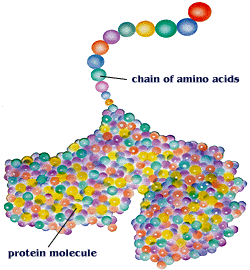

Hydrophobic side chains interact with each other via weak van der Waals interactions. Charged amino acid side chains can form ionic bonds, and polar amino acids are capable of forming hydrogen bonds. The chemistry of amino acid side chains is critical to protein structure because these side chains can bond with one another to hold a length of protein in a certain shape or conformation. Several other amino acids have side chains with positive or negative charges, while others have polar but uncharged side chains. The largest group of amino acids have nonpolar side chains. The side chains of amino acids have different chemistries. Proteins are built from a set of only twenty amino acids, each of which has a unique side chain. The linear sequence of amino acids within a protein is considered the primary structure of the protein. Peptide bonds are formed by a biochemical reaction that extracts a water molecule as it joins the amino group of one amino acid to the carboxyl group of a neighboring amino acid.


Within a protein, multiple amino acids are linked together by peptide bonds, thereby forming a long chain. The building blocks of proteins are amino acids, which are small organic molecules that consist of an alpha (central) carbon atom linked to an amino group, a carboxyl group, a hydrogen atom, and a variable component called a side chain (see below).


 0 kommentar(er)
0 kommentar(er)
